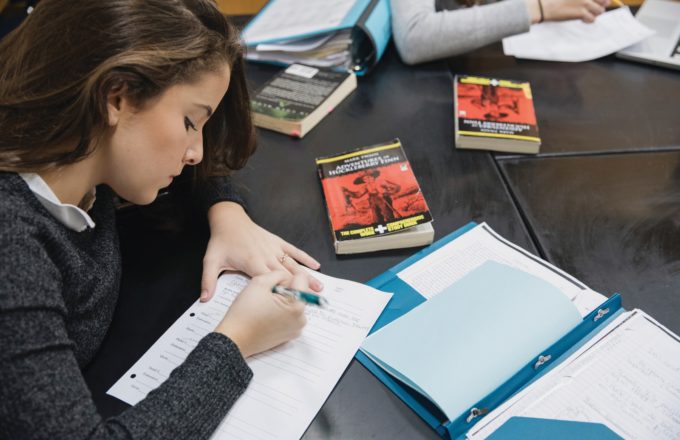This post is part of a series about helping students with LBLD experience academic success.
Read Erin’s other blog posts:
I’m sure I’m not the only one who has made this mistake. “Rewrite the chapter from another character’s point of view,” I instructed my students a few years ago, feeling good about this creative, more interesting variation of writing a chapter summary. After collecting their work, I sat down to read their stories and immediately realized my error. “I think that ___ would feel sad,” one essay read. “If I were ____, I would be really angry,” read another. It occurred to me that, despite likely having being taught this skill in the past (especially now, since it is a commonly recurring question type on the Next-Generation MCAS), my students did not understand what it meant to write a scene from a different point of view. This is a great example of a skill that we might think, okay, they’ve been exposed to it before, they know how to do it – when, actually, students really may lack that inherent understanding of what you are asking them to do, of what that task really looks like. This is where scaffolded, explicit, direct instruction and modeling are needed – when we identify a skill that our students have learned in the past but are still struggling to apply independently.
As with my scary story unit, I wanted to break the skill of writing from a given point of view down to figure out how to best approach it. What does it really mean, and what prior knowledge or skills are required to write a story from another point of view? From years of teaching in special education, particularly language-based settings, I have learned to approach any task that my students are struggling with by first asking myself: How can I break this down more? What prerequisite skills do I need to teach or review? To rewrite a story, or continue a story, from a different point of view, students have to first understand the story itself – their basic comprehension of the story’s plot must be fairly solid. After that, they need to be able to differentiate between the two characters: How is one character’s experience of these events different from another character’s?
For some students with language-based learning disabilities, this task may be particularly daunting. Some students with LBLD struggle to understand another individual’s point of view in real life, let alone in stories, due to weaknesses in pragmatic language (social communication and discourse) or weaknesses in receptive and/or expressive language skills. For these students, learning to make inferences about a character’s behavior, emotions, and motivations may be particularly challenging and need to be broken down even further; I have at least one such student in my class each year.
How to teach students to write from different perspectives
Introduce Perspective: To begin this mini-unit on writing from another character’s point of view, I led a group brainstorm and discussion about what point of view means. Several students remembered from our short story unit that it refers to the perspective from which a story is told. With a little prompting, they could also recall that stories can be written from a first-person narrator’s point of view or a third-person narrator’s point of view, and that third person narration can at times focus on one character (third person limited) and at other times focus on multiple or even all characters (third person omniscient). We talked a little bit about the general topic of perspective, and how each person experiences an event slightly differently, based on his or her background experiences, emotional state, and other factors. I gave a real-life example of a hypothetical argument (based on many, many actual arguments that have taken place in this particular group!) where two students argue over a group project in which one student completed the majority of the work. I asked my students to brainstorm what is going on inside each student’s mind. What are some possible reasons why one student did all of the work? What are some possible reasons why the other student did not do his or her fair share? How would the story of this argument be written if it was written from each student’s perspective?
Practice: We then did a short creative writing activity. I passed out a scenario involving 12-year-old Julian, who goes out to lunch with his mother. I’ve attached the scenario to this blog, but to summarize, the waitress gives them a little bit of attitude, and she ends up spilling young Julian’s milkshake all over his lap. The waitress bursts into tears and leaves the restaurant, and the manager comes over, visibly upset with the waitress, and apologizes profusely to Julian and his mother. I then told my students that they were going to write this scene from an assigned point of view. I stressed to them that they would be required to use first person narration – they WERE that character, and they were experiencing the events AS that character (my previous experiences taught me to perhaps over-emphasize that point this time!) Students received a strip of paper with a character: Julian, his mother, the waitress, and the manager. They were then given ten minutes to tell this story from that perspective.
This exercise was certainly a success when compared to my previous attempts to have students accomplish this task with less pre-loaded skill instruction. Some of the students’ stories were particularly wonderful; one student created a whole backstory for the waitress where she had just seen her younger brother lunching with a professor whose program she had recently been dismissed from, and she was upset about this lost opportunity to further her education and angry with her brother. Another student was able to perfectly capture the irritated voice of the manager and create a character in a few paragraphs. One important point about these creative “quickwrites,” which I try to give at least a few times a week on different topics: I never, ever, ever grade them (aside from an effort grade at times) or mark them for spelling or grammar. I want these wonderfully bright and creative kids to have some moments of their days in which they are evaluated solely for the quality of their ideas, and not for their occasional (or at times regular) lack of adherence to well-reviewed orthographic principles. I felt that after completing this quickwrite, students showed me that they understood what it meant to write from another person’s point of view in first person. (And in an accidental but welcomed bonus, this exercise also led to a discussion about empathy and how you never really know what’s going on with any other person at any given time!) Now we were ready to tackle this same task in a longer, more formal narrative piece.
Apply: For our final assignment, on a colleague’s suggestion, I used Sandra Cisnero’s short story “Eleven.” This story is written in third person, but it tells the story of young Rachel who, on her eleventh birthday, is humiliated by her teacher in front of her entire class. Her teacher, the possibly-well-intentioned Mrs. Price, gives Rachel a red sweater that someone left behind. She insists that the sweater belongs to Rachel even though Rachel says it does not. The teacher makes Rachel put on the sweater, which in Rachel’s observation is “raggedy and old” and “itchy and full of germs,” in front of the entire class. After this scene plays out, another student in the class realizes that the sweater is hers – but rather than feeling vindicated, Rachel is left with the humiliation of the incident, feeling as though Mrs. Price has singled her out as shabby and ill-dressed. To ensure that students fully understood the story and the emotions of the characters, I provided them with a note-taking template. I asked them to track each character’s actions and emotions first by highlighting, and then by working with a partner to add their ideas to the note template. They answered questions about the story for homework that night, and the next day we had a discussion about why Rachel was so humiliated and upset by this experience.
Before asking my students to write their own narrative piece, I provided them with one last template, where they were asked to brainstorm what Mrs. Price might have been thinking. I wanted to really isolate that skill of giving a character, previously a one-faceted quasi-villain in the story, a point of view. I asked students to brainstorm how Mrs. Price saw the sweater, and several students wrote that perhaps she saw it as cozy, not ragged. Others wrote Mrs. Price’s point of view more consistent with how she probably saw Rachel: insecure, afraid to speak up, possibly rude and ungrateful when handed the sweater. Once students completed this exercise, several of them were excited to write their story because of the character they had created, which made me realize that writing point of view really is about creating character, rounding out the perspective and the traits of a character who perhaps wasn’t given a voice in the original story.
Reinforce Skills: As always, I gave students a brief checklist of the skills I wanted them to include: they had to write in the first person, they had to include events from the original story, they had to include Mrs. Price’s thoughts and feelings, and they had to include correctly punctuated dialogue, as this has been a skill we’ve worked on all year. Overall, students’ stories met these criteria, and they showed me that they could write a story from a particular character’s point of view when given some vocabulary and skill instruction up front. My hopes are that when I give them an MCAS story and prompt that asks them to continue or rewrite a story from another character’s point of view in our class testing review, it will only take a brief reminder of those other assignments for them to remember what that means. I want them to see it as a creative exercise, not yet another dreaded essay, and (hopefully) to at least try to have a little fun with it!



